

Virtual Earthquake - An Introduction. What's an earthquake?
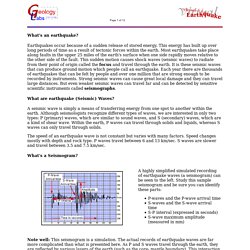
Earthquakes occur because of a sudden release of stored energy. This energy has built up over long periods of time as a result of tectonic forces within the earth. Most earthquakes take place along faults in the upper 25 miles of the earth's surface when one side rapidly moves relative to the other side of the fault. This sudden motion causes shock waves (seismic waves) to radiate from their point of origin called the focus and travel through the earth. It is these seismic waves that can produce ground motion which people call an earthquake.
What are earthquake (Seismic) Waves? A seismic wave is simply a means of transferring energy from one spot to another within the earth. The speed of an earthquake wave is not constant but varies with many factors. What's a Seismogram? Note well: This seismogram is a simulation. How is an Earthquake's Epicenter Located? Ohio Earthquake Information. The Changing Oceans. The face of the Earth is always changing and throughout geologic history oceans have been created and destroyed.
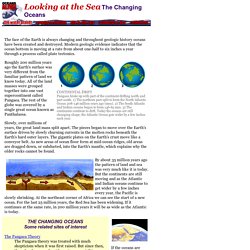
Modern geologic evidence indicates that the ocean bottom is moving at a rate from about one-half to six inches a year through a process called plate tectonics. Seafloor Spreading Animation - Earthguide Online Classroom. Seafloor spreading. Cascades Volcano Observatory Why Study Cascade Volcanoes? Cascade Range Active volcanoes dominate the skyline of the Pacific Northwest.
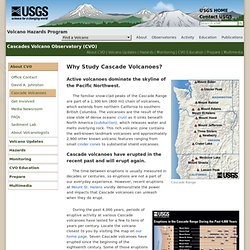
The familiar snow-clad peaks of the Cascade Range are part of a 1,300 km (800 mi) chain of volcanoes, which extends from northern California to southern British Columbia. The volcanoes are the result of the slow slide of dense oceanic crust as it sinks beneath North America (subduction), which releases water and melts overlying rock. This rich volcanic zone contains the well-known landmark volcanoes and approximately 2,900 other known volcanic features ranging from small cinder cones to substantial shield volcanoes. Cascade volcanoes have erupted in the recent past and will erupt again.
The time between eruptions is usually measured in decades or centuries, so eruptions are not a part of our everyday experience. SeaFloorSpreading. Interactives. Dynamic Earth. Earth's Structure. Layers of the Earth and Seismic Waves. GCSE Bitesize: Seismic waves activity. Welcome to Understanding Geologic Time. Geologic Time. Initially compiled by Laurie Cantwell, Montana State University This section highlights animations, images, interactive graphics and videos used to teach the concept of geologic time in an introductory geology course.

Geological Time Scale WebQuest. Plate Tectonics. Geologic Hazards. Some volcanic eruptions are mild and slow, while others are powerful and dramatic.
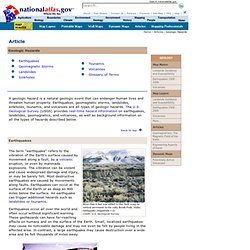
An eruption happens when magma, gases, or steam break through vents in the Earth's surface. A mild eruption may simply discharge steam and other gases, or quietly extrude lava. Science In Your State: Ohio. USGS Education. Educational Videos. Earth Making Of A Planet (Complete Film) How the Earth was Made. Birth of the Earth (full episode) (how the Earth was made) Virtual Labs. The links on this page are all VIRTUAL LABS offered by the Glencoe textbook company.

These labs give the students the adventure of laboratory experimentation without costly supplies, worrisome environmental and safety issues, or time-consuming clean up. They are from all different areas of science: Biology, Physics, Genetics, Earth Science, Physical Science, and Chemistry. Please feel free to try these at home! Students will be directed to specific labs in class but there are over 100 labs offered here!
To return to the home page, please click here: Virtual Labs 1) What strategies are involved in solving a science problem? Exploring Earth Visualizations. Earth Science Virtual Labs. PhET Lab: Plate Tectonics. Topics Plate Tectonics Crust Lithosphere Mantle Density Buoyancy Earth Science Description Explore how plates move on the surface of the earth.
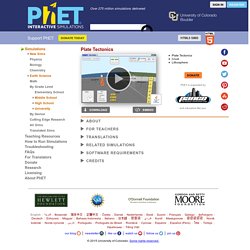
Change temperature, composition, and thickness of plates. Discover how to create new mountains, volcanoes, or oceans! Sample Learning Goals Describe the differences between oceanic and continental crust, including their respective properties of density, composition, temperature and thickness.Predict how changes in composition and temperature change crust density and buoyancy.Draw a time series for different types of plate boundaries and their motions, indicating the related surface features.Deduce the type of plate boundary given images or descriptions of surface features.Explain which types of plate boundaries create crust, and which destroy crust Version 1.02. PhET Lab: Radioactive Dating Game. SAVAGE EARTH Online. Please note: SAVAGE EARTH ONLINE looks best when viewed using Netscape 3.0 or above, or Internet Explorer 3.0 or above, on Macintosh, Windows 95 or Windows 3.1.
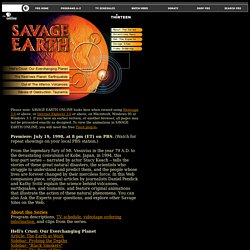
If you have an earlier version, or another browser, all pages may not be presented exactly as designed. To view the animations in SAVAGE EARTH ONLINE, you will need the free Flash plug-in. Premiere: July 19, 1998, at 8 pm (ET) on PBS. (Watch for repeat showings on your local PBS station.) Volcanoes. Ring of Fire. The Ring of Fire is a string of volcanoes and sites of seismic activity, or earthquakes, around the edges of the Pacific Ocean.
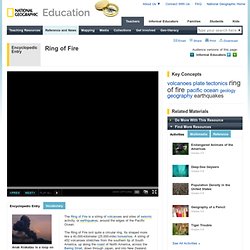
The Ring of Fire isnt quite a circular ring. Its shaped more like a 40,000-kilometer (25,000-mile) horseshoe. LANDFORM DETECTIVES. Examine a landscape formed by erosion. Science NetLinks: Shape It Up! Glaciers Virtual Lab.